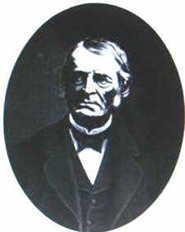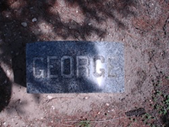


George Crane, son of George Crane Sr. and Phebe Aldrich, was born on March 30, 1783 in Taunton, the county seat of Bristol County, Massachusetts.[1] George was born into a Quaker family. He received a common school education. At age twenty-one, he married Charity Lincoln on April 29, 1804 in Taunton. To their union were born seven children.[2]
Soon after their marriage, George, Charity, and their newborn child left Massachusetts seeking a home in what was then called the “Far off Genesee,” traveling a distance of four hundred miles into wilderness country. George drove his team over mountain and glen for twenty-two days before reaching Palmyra. It was said of his travels and his settling in Palmyra—
His means were small, his hardships great, but his constitution was good, and his courage indomitable. Success at length crowned his labors with a comfortable home and many of the enjoyments of life, which he freely shared with his friends, remembering also the stranger that was within his gate.[3]
Once settled on farmland near Stafford Road, the road that passed through the Joseph Smith Sr. property, George saw the need for a “surveyor, as there was none” in the area. He purchased the necessary equipment “with all the information then to be obtained, and spent every spare moment in the study and practice of surveying.” Before long, he became “a competent and reliable surveyor and engineer, and did a large amount of business in that line.” George is credited with surveying much of Palmyra, including the Joseph Smith Sr. property and the Isaac Durfee property. In Macedon, he surveyed the property of Lemuel Durfee Jr. As for being a merchant, a member of the Mason Lodge, or a civic officer in Palmyra, he was not. His social life was confined to the large enclave of Quakers in the area.
From 1805 to 1823, George and his family resided in Palmyra. In 1823, Macedon was created from the western half of Palmyra. At that point, George became a resident of Macedon. He lived in Macedon from 1823 to 1831, named after the birthplace of Alexander the Great in ancient Macedonia.
During his years in Palmyra and Macedon, George attended Quaker meetings held on the Lemuel Durfee Sr. farm, about two miles north of the Palmyra village.[4] Also attending those meetings were members of the Durfee family and members of the Nathan and Rufus Harris families, including Martin, Lucy, and Peter Harris. In the meetings, George was acknowledged as an elder.
George Crane named in the Fayette Lapham Article
George Crane was named in the now famous Fayette Lapham article that appeared in the Historical Magazine in May 1870. The article reads:
Joseph, not being able to read the characters, made a copy of some of them, which he showed to some of the most learned men of the vicinity. All the clue he could obtain was from George Crane, who said he had seen a Pass that had been given to Luther Bradish, when traveling through the Turkish dominions; and he thought the characters resembled those of that Pass.[5]
A “Pass” is like a passport. Apparently, George was shown by Luther Bradish, a student of languages and a traveler in the Middle East, his “Pass” as verification of his travels. But then it becomes confusing. Either Fayette Lapham or George Crane was confused about who showed Crane a copy of the characters. If Crane did see a copy of the characters, he would have been shown them by Martin Harris.
Fayette Lapham is the only contemporary of George Crane who refers to him and the characters. George Crane does not make any notations about the characters copied from the gold plates.
Joseph Smith asking George Crane for Money
The more familiar account of George Crane and Joseph Smith is of Joseph sharing pages from the Book of Mormon with George Crane and then asking George for money to defray the costs of publishing the book. Contemporary Stephen Harding wrote,
In the neighborhood of Palmyra there lived another prophet, older and wiser than the Mormon prophet. This was old George Crane [at the time George Crane was in his forties], who had been born and brought up a Quaker. On one occasion Smith and Cowdery had gone to the house of George, who had manifested some interest in the pretended translation. It was in the evening, and when several chapters had been read. Mr. Crane, who had been an attentive listener, in his straightforward, Quaker soberness said: “Joseph, thy book is blasphemous; and I counsel thee to mend thy ways, or thee will come to some bad end.”[6]
John W. Barber and Henry Howe wrote the “Barber & Howe Account” in 1841 of George Crane and Joseph Smith. In that account, they wrote, “Not having the means to print his revelations, [Joseph Smith] applied to Mr. Crane, of the Society of Friends, declaring that he was moved by the spirit to call upon him for assistance. This gentleman bid him to go to work, or the state prison would end his career.”[7]
Pomeroy Tucker, editor of the Wayne Sentinel and author of an anti-Mormon book, also wrote of the conversation between Joseph Smith and George Crane:
Mr. George Crane, of the adjoining town of Macedon, a Quaker of intelligence, property, and high respectability (now deceased), was called upon by [Joseph] Smith with several foolscap quires of these so-called translations, for his perusal and opinion, and also for his pecuniary aid to get the work through the press. The impious story, in all its extravagance and garniture, was related to him, to which he quietly listened to the end. And then came the answer of the honest old Quaker, which was such as would have been withering to the sensibility of an ordinary impostor . . . Mr. Crane kindly but earnestly admonished him, for his own good, to desist from his criminal pursuit, warning him that persistence therein would be certain to end in his death upon the gallows, or in some equally ignominious manner.[8]
George Crane moves to Palmyra, Lenawee County, Michigan
In 1830, George Crane was still residing in Macedon.[9] In June of 1831, he was appointed director of the Wayne County Bank along with suspects Thomas Rogers II, Nathaniel H. Beckwith, George Beckwith, and Pliny Sexton.[10] Although George accepted the appointment, he was planning to move from Macedon, New York to Palmyra, Lenawee County, Michigan.
In 1831, George sold his holdings in Palmyra and Macedon. With monies received from sales, he purchased four hundred acres in section eighteen in Palmyra, Michigan from Benjamin I. Mather. Shortly thereafter, George acquired additional land from the US government until he owned 2,500 acres.
On May 26, 1833, George Crane and his relatives arrived in Palmyra, Michigan. During his first year in Palmyra, George built a frame house, the first frame building erected in the township.[11] Within a year or so, he built a large brick house, the first brick building in the township.
Quakers. George was an earnest elder of the Society of Friends when he moved to Michigan. When a Friends’ meetinghouse was proposed, George gave three acres of land on which to build the meetinghouse and a Quaker burial ground.
Railroad. George was a stockholder and director of the Erie & Kalamazoo Railroad Company, organized in 1834 to construct a railroad from Toledo, Ohio to Adrian, Michigan. Because of his knowledge of surveying, George was named one of three commissioners to locate the road. At a later date, he was elected president of the road. During his presidency, George executed a lease to the road (in behalf of the railroad company) for ninety-nine years to the Michigan Southern Railroad Company.[12] He was highly esteemed by those interested in the prosperity of the road, and his advice and good judgment were generally received in preference to others.
Surveyor. George had the responsibility of surveying the land between Adrian and Ottawa Lake, Michigan.
Civic Positions. George was the first supervisor of Palmyra (equivalent to being mayor), and was re-elected several times. He was also a county commissioner. He was a two-term representative to the Michigan Legislature, representing Lewanee County in the 1850s. Historians of Lewanee County claim that George Crane was “one of the most prominent men of the county in its early history. He was generous, honest, pure and unselfish, and had the respect and confidence of all classes of people.[13]
Death of George Crane
George Crane died on April 17, 1856 at his home in Palmyra, Michigan at age seventy-three. A prominent Michigan Quaker wrote of him,
[George Crane] became an influential member of the community, and engaged actively in the philanthropic objects of the day. Diligent in providing for his large family, watching unto prayer, he sought to do with all his might whatever his hand found to do. Believing the system of slavery to be unchristian, he bore a faithful testimony against it, not shrinking from the cross that was involved in abstaining as much as possible from the products of slave labor.
His concern for the welfare of our Society was very great. He was a diligent attender of our midweek Meetings, often bearing his testimony to the value of these seasons, when, amidst the pressure of the things of time, he could retire from them, and entering into the closet of the heart, wait upon the Lord in spirit and in truth. In his closing scene, the truth of the words was exemplified, ‘Mark the perfect man, and behold the upright, for the end of that man is peace.’”[14]
George was buried in the Crane Cemetery (Quaker Cemetery) in Palmyra, Lenawee County, Michigan. His widow, Charity Crane, died in their family home in Palmyra on September 21, 1863.
Children of George and Charity Crane
1. Phila P. Crane (December 6, 1804–1808). She was born in Taunton, Massachusetts.
2. Elizabeth W. Crane (February 5, 1807–1845). She was born in Macedon, New York. She married Isaac A. Colvin. She died in Hudson, Michigan.
3. Rowena C. Crane (February 2, 1809–1849). She married John T. Comstock.
4. George L. Crane (November 20, 1810–1891). He resided in Madison, Michigan.
5. Benjamin L. Crane (October 29, 1812–1867). He married Ann Eliza Hoag. He died in Adrian, Michigan.
6. Calvin Crane (December 25, 1816–1901). He married Deborah Power. He resided in Adrian, Michigan.
7. Clarissa P. Crane (February 22, 1824–March 1, 1857). She married George W. Freeman. She died in Palmyra, Michigan.
[1] Massachusetts, Town and Vital Records, 1620–1988.
[2] Early Histories of Michigan: With Biographies of State Officers, Members of Congress, Judges and Legislators. 1888.
[3] Early Histories of Michigan.
[4] Cook, Palmyra and Vicinity, pp. 192–193.
[5] Fayette Lapham, Esq., “Interview with the Father of Joseph Smith,” Historical Magazine (May 1870), p. 307.
[6] Stephen S. Harding quote, in Gregg, The Prophet of Palmyra (1890), p. 40.
[7] John W. Barber and Henry Howe, “Barber & Howe Account.” Historical Collections of the State of New York (1841), p. 581.
[8] Tucker, Origin, Rise, and Progress of Mormonism, pp. 36–37.
[9] US Federal Census, 1830.
[10] The Geneva Gazette and Mercantile Advertiser, June 29, 1831.
[11] Early Histories of Michigan, p. 206.
[12] Early Histories of Michigan, p. 206.
[13] Landsmen of Lenawee County Michigan, p. 202.
[14] Early Histories of Michigan, p. 206.
